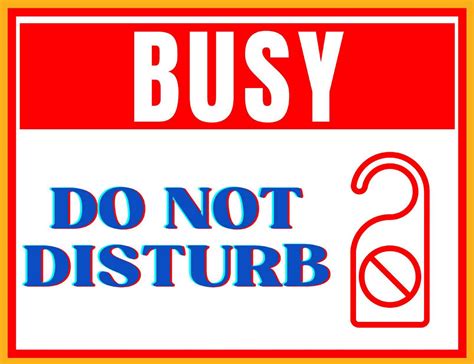Introduction

In an era marked by constant distractions and an overwhelming barrage of information, creating a focused work environment is crucial for productivity and well-being. A “Do Not Disturb” sign for office is an effective tool that can help employees minimize interruptions and maximize their output. This comprehensive guide will provide an in-depth exploration of the benefits, strategies, and best practices associated with utilizing a “Do Not Disturb” sign in an office setting.
Benefits of Using a “Do Not Disturb” Sign
1. Increased Productivity:
Studies have shown that interruptions can significantly disrupt cognitive processes and reduce productivity by up to 50%. By limiting interruptions, a “Do Not Disturb” sign can create a more focused and productive work environment.
2. Enhanced Focus:
When employees can work uninterrupted, they can better concentrate on their tasks and maintain a high level of focus. This leads to improved accuracy, reduced errors, and increased efficiency.
3. Improved Job Satisfaction:
Employees who feel in control of their work environment and have the ability to minimize interruptions report higher levels of job satisfaction. A “Do Not Disturb” sign empowers employees to create a personalized workspace that supports their productivity and well-being.
4. Reduced Stress and Anxiety:
Constant interruptions can increase stress levels and create a sense of anxiety. By eliminating unnecessary distractions, a “Do Not Disturb” sign can promote a calmer and more relaxed work environment.
Strategies for Effective Use
1. Establishing Clear Boundaries:
Communicate the purpose and importance of the “Do Not Disturb” sign to colleagues and other individuals who may need to interact with you. Explain that interruptions should be limited to urgent or critical matters.
2. Designate Specific Work Time:
Determine the periods during the day when you require uninterrupted work. Clearly display the “Do Not Disturb” sign during these times and stick to them consistently.
3. Use Headphones or Earplugs:
Create a physical barrier to noise by wearing headphones or earplugs. This can further minimize distractions and enhance focus.
4. Communicate Availability:
Inform colleagues of your scheduled “Do Not Disturb” times and provide alternative methods of communication for urgent matters, such as email or instant messaging.
Best Practices
1. Respect the Sign:
Encourage colleagues to respect the “Do Not Disturb” sign and limit interruptions accordingly. If someone does need to approach you, they should knock lightly and wait for your response.
2. Use the Sign Politely:
When displaying the “Do Not Disturb” sign, accompany it with a friendly and professional note to indicate that interruptions are not welcome.
3. Be Transparent:
Communicate to colleagues the specific reasons why you are using the “Do Not Disturb” sign, such as meeting deadlines or completing important tasks. This can help foster understanding and reduce potential frustrations.
4. Take Breaks:
Avoid using the “Do Not Disturb” sign for extended periods. Take regular breaks to move around, socialize, and recharge your mind.
Common Mistakes to Avoid
1. Overdoing It:
Using the “Do Not Disturb” sign too frequently can isolate you from colleagues and limit collaboration. Strike a balance between uninterrupted work and necessary interactions.
2. Lack of Communication:
Failing to communicate your “Do Not Disturb” schedule or ignoring urgent requests can damage relationships with colleagues and impact work quality.
3. Disregarding Urgent Matters:
It is important to set aside the “Do Not Disturb” sign for urgent or critical situations. Regularly check for important emails or messages to avoid missing crucial information.
Creative Tips and Tricks
1. “Do Not Interrupt” Zones:
Establish designated areas in the office where all employees are expected to respect the “Do Not Disturb” sign, creating a sanctuary for focused work.
2. Smart Use of Technology:
Utilize tools like noise-canceling apps or white noise machines to further minimize distractions and enhance focus.
3. “Focus Mode” Collaboration:
Encourage colleagues to schedule specific “focus mode” periods, during which the entire team adheres to the “Do Not Disturb” sign, promoting collective productivity.
4. “Pomodoro Technique” with a Twist:
Implement the “Pomodoro Technique” by working for focused intervals, followed by short breaks. During the “Pomodoro” intervals, display the “Do Not Disturb” sign to maximize focus.
Tables
Table 1: Productivity Impact of Interruptions
| Source | Impact |
|—|—|
| University of California, Irvine | 50% reduction in productivity |
| University of Michigan | 25% increase in error rate |
| McKinsey & Company | 10% decrease in work efficiency |
Table 2: Strategies for Effective Use of “Do Not Disturb” Sign
| Strategy | Description |
|—|—|
| Clear Boundaries | Establish specific times for uninterrupted work |
| Designate Work Time | Display the sign during designated periods |
| Headphones or Earplugs | Wear headphones or earplugs to block noise |
| Communicate Availability | Inform colleagues of scheduled “Do Not Disturb” times |
Table 3: Best Practices for “Do Not Disturb” Sign
| Practice | Description |
|—|—|
| Respect the Sign | Encourage colleagues to limit interruptions |
| Use the Sign Politely | Accompany the sign with a friendly note |
| Be Transparent | Communicate the reasons for using the sign |
| Take Breaks | Avoid extended use of the sign |
Table 4: Tips and Tricks for Enhanced Productivity
| Tip | Description |
|—|—|
| “Do Not Interrupt” Zones | Establish designated distraction-free areas |
| Smart Use of Technology | Utilize noise-canceling apps or white noise machines |
| “Focus Mode” Collaboration | Schedule periods of collective focus |
| “Pomodoro Technique” with a Twist | Display the sign during “Pomodoro” intervals |
Conclusion
A “Do Not Disturb” sign for office is a valuable tool that can empower employees to create a focused and productive work environment. By implementing the strategies and best practices outlined in this guide, organizations can cultivate a culture of respect, collaboration, and uninterrupted productivity. The benefits of using a “Do Not Disturb” sign extend beyond increased output and enhanced focus; it also promotes job satisfaction, reduces stress, and ultimately leads to a more positive and fulfilling work experience.
